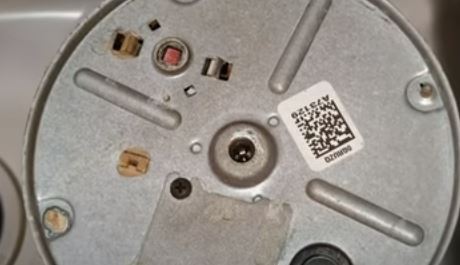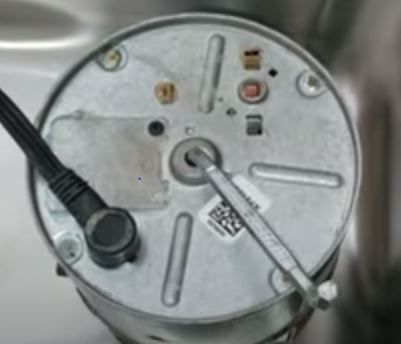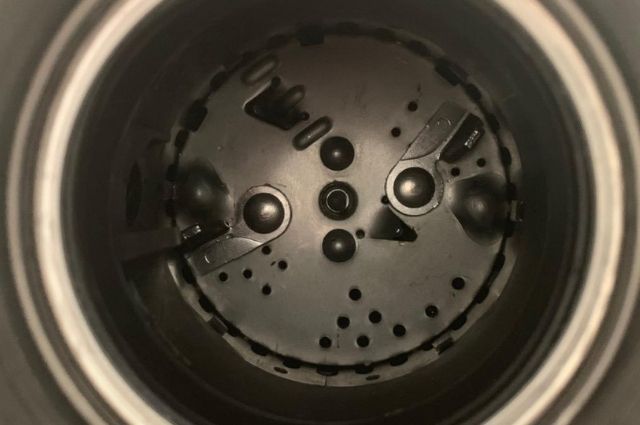The way a garbage disposal works is that a motor inside rotates blades which in return grinds the waste entering it from the dishwasher or sink. The blades can however not grind everything. If you put in something that should not be put in it you will have problems.
A humming garbage disposal is a sign that the unit is receiving power but the blades are not turning, either because they are jammed or the motor is faulty. That usually happens when something that shouldn’t be put in the unit ends up being put there.

To fix a humming garbage disposal, turn off the power and unplug the unit. Stick an Allen wrench in the slot underneath the disposal and turn the motor manually to free the blades. Plug in the unit and turn on the power.
If the humming continues motor is most likely faulty faulty and you will have to replace the whole unit.
A garbage disposal that is humming but the flywheel is not stuck is usually as a result of a tripped GFI, meaning power is not getting to the disposal. If this is the case, pressing the garbage disposal reset button is enough to fix the problem.
How to Fix a Humming Garbage Disposal
In this post, I will give you both the summary and the detailed explanation and solution to the problem. Let us start with the summary:
- Reset the Disposal: Locate the reset button on the bottom of the disposal unit and press it. This can often resolve the issue if it has overheated or tripped.
- Turn Off Power: Before attempting any fixes, ensure the power to the garbage disposal is turned off to avoid accidents.
- Clear Jams: Insert an Allen wrench or disposal wrench into the disposal’s hexagonal opening on the bottom, gently turn the wrench clockwise and counterclockwise to free any jammed blades.
- Remove Foreign Objects: Disconnect power, use tongs or pliers to remove any foreign objects (e.g., utensils, bones) causing the jam and never insert your hand into the disposal.
- Check for Obstructions: Inspect the disposal chamber for any remaining debris or food particles and remove them.
- Reset the Circuit Breaker: If the disposal has a built-in circuit breaker, locate and reset it.
- Lubricate: Apply a small amount of food-grade lubricant to the disposal’s bearings to ensure smooth operation.
- Check Electrical Connections: Ensure the disposal is properly connected to the electrical supply and no loose wires are causing the issue. Consult an electrician if needed.
- Replace the Disposal: If none of the above solutions work, and the humming persists, it may be time to consider replacing the disposal unit, as there could be a motor or internal component failure.
Now the long and detailed explanation:
1. Remove the Foreign Object
As we have already seen, a humming garbage disposal is usually caused by a foreign object that should not be inside it. This is especially the case if you have kids in the house.
- Flip the garbage disposal switch to the off position. Just to be safe, I would also advise that you unplug the disposal unit just in case someone turns on the power accidentally.
- Grab a flashlight and inspect the inside of the garbage disposal. Look for objects that could be jamming the blades resulting in the humming sound.
- If you see any, use a pair of needle-nose pliers or tongs to remove the object(s). Never put your hand or fingers inside the garbage disposal.
- When done plug in the unit.
- Turn on the hot water and start the garbage disposal. Listen careful if the humming sound has stopped.
If the buzzing and humming has stopped then it is all good for you. In case the above did not yield any fruits then try the methods below.
2. Press the Reset Button

Every garbage disposal has a reset button underneath it. Whenever you have a garbage disposal that is humming but the blades are spinning (not jammed), the problem can be attributed to tripped ground fault interrupters (GFI).
GFI circuit breakers are a fail-safe system that prevent electrical shock by turning off power to an appliance if/when they detect an energy leak. You might not be aware if your garbage disposal’s GFI has tripped until you check.
When the GFI trips, power will not reach the motor. This can also cause the humming sound.
The solution to this problem is to press/push the reset button and connect back power supply to the garbage disposal. If you have been trying to fix your garbage disposal for some time, I suggest you give it a few minutes for the motor to cool off.
Before pressing the reset button make sure that the switch is in the OFF position.
When the garbage disposal has sufficiently cooled off, look for a red button under the disposal and press it (in others press and hold). Turn on the power to the unit and listen if the humming has stopped.
3. Turn the Garbage Disposal Blades Manually

If the garbage disposal is humming and not working a result of the blades being jammed by a foreign object, spinning the blades manually will force them to grind the object (assuming it should be grinded) and in the process free up the blades.
Most garbage disposals are sold with an Allen wrench specifically for this purpose. This is usually done via a hole/slot found underneath the disposal unit at the center.
- Locate the Allen wrench and insert it in the slot. Turn the wrench gently to grind the clog. If you don’t have the exact wrench that the unit came with, use any other Allen wrench (1/4) that you have as long it fits in the slot.
- As a sign that the clog has been grinded, in most cases you notice the Allen wrench will be spinning more freely/easily than before. Turn on the hot water to the disposal and flip on its switch. Listen if the humming has stopped.
- If you don’t have an Allen wrench, a piece of wooden stick will also do. Stick the wood inside the garbage disposal and use it to manually turn the blades. Remove the stick and turn on the power to the disposal. Check if the humming has stopped
To prevent further damage to the garbage disposal, always run water while you are testing it and don’t keep it running for more than a minutes. Also, give it time to cool off in between tests.
4. Remove and Clean the Garbage Disposal

If you have a garbage disposal that is humming and draining slowly, or not draining at all, it is assign that you have a clog in the drainpipe or P-trap.
A P-trap or S-trap is the U-shaped part of the drainpipe. It traps clogs preventing them from clogging the drainpipe further below.
Removing the garbage disposal and unclogging the P-trap might sound like a daunting task but the truth of the matter is that it is actually very easy. At most it should only take you 30 minutes.
A garbage disposal is connected to the sink using a mounting ring. A flexible pipe (usually grey) runs from the dishwasher and connects to the top of the disposal. Another bigger plastic pipe drains the garbage disposal to the drainpipe via the P-trap.
Here is how to remove a garbage disposal:
- Turn off the power to the garbage disposal and unplug it.
- Clear the space under the kitchen sink. If you have stored anything under the kitchen sink take it out to give you enough space to work.
- Locate the P-trap. Put a bucket or basin under the P-trap. There is always water in the pipes and you really don’t want it to spill on the floor.
- Loosen the P-trap. The P-trap has 2 connections. One is usually higher than the other. Start by loosening the one below. This will allow all the water in the pipe to flow out via gravity. Before reaching out for a wrench to loosen the connections, attempt to do so with your bare hands first.
- Once out, inspect the status of the P-trap. Is it clogged? Check for gunk in the tailpipe leading to the trap and the drainpipe as well.
- Clean the P-trap as well as the drainpipe.
At this point, you can decide not to remove the garbage disposal since you have already unclogged the P-Trap.
- Connect the P-trap back and test the garbage disposal one more time.
If the humming has stopped then you are lucky. Sometimes if you have a small piece (like a screw) in the disposal, unclogging the P-trap will not be enough, you will need to remove the P-trap and remove the piece.
- Remove the P-trap
- If your disposal is connected to the dishwasher, remove the hose.
- On the mounting ring where the garbage disposal is connected to the sink drain opening, you will see 2 round holes/slots. Insert a screwdriver in one of them and turn it counterclockwise to release it. Alternatively just grab the entire disposal and turn it.
- Take out the rubber seal to have a good view of the inside of the garbage disposal.
With the garbage disposal out, you can easily remove whatever that is jamming the blades and causing it to produce the humming sound.
If you don’t find anything, there is a possibility that your garbage disposal motor is just faulty. While repairing a garbage disposal motor is possible, most often the best decision is to replace the entire garbage disposal.
- Once you are done inspecting and cleaning the garbage disposal, put it back pretty back the same way you removed it.
Considering Garbage Disposal Replacement?
In case you would like to replace your old garbage disposal with a new one, there are few things that you need to know. To start with, newer garbage disposal models are quitter than old models. That is one advantage if replacing your old disposal.
You should also consider the size of the garbage disposal that will serve you well. Bigger garbage disposals can handle more waste than smaller ones and are more powerful.
You will also need to choose between batch and continuous feed garbage disposals. Batch feed garbage disposals come with a cover and don’t allow you to add waste when they are running.
With a continuous batch feed garbage disposal, you can keep adding waste as the one inside the unit is still being grinded. It does not need a cover to allow you to continuously add waste into it.





